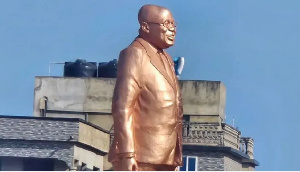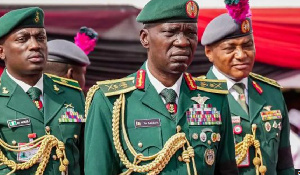Opinions of Tuesday, 7 July 2015
Columnist: Obeng, Samuel Kwasi
Explore Ghana: Exploring The Northern Region Of Ghana
By Samuel Kwasi Obeng
www.mrsamko.blogspot.com
In a WhatsApp conversation I had with my friend, Akwesi, a few months ago, I asked him what he thinks is the bane to the progress of our country. Akwesi first sighed a big hmmm; indicative of how frustrating the problem has become to him. He then went on and said we talk and write, almost perfectly, the solutions to our problems but do little with it. He argued further that this country will only move forward if ‘men of speeches’ become ‘men of action’; those who talk, must do.
My instinctive response to Akwesi’s submission was ‘bingo! You’ve made my point’. Truly, it is easier said than done to most people in our part of the world. Only few people walk their talk and that has been one of the major barriers to our progress. The Hon. Minister for Tourism, Culture and Creative Arts, Mrs. Elizabeth Ofosu-Adjare has however demonstrated with her Explore Ghana initiative, an initiative to drive domestic tourism, which she launched last year that she is among the few who walk their talk.
She has been leading a delegation of stars in the creative arts industry, policy makers and implementers in the tourism, culture and creative arts sector to visit and project tourist sites across the country. This is to make good her promise to promote domestic tourism with her Explore Ghana initiative. The promotion of domestic tourism is one of the functions of the Ministry of Tourism Culture and Creative Acts (MOTCCA), provided by the Tourism Act, 2011 (Act 817).
The Explore Ghana initiative is an initiative aimed at exposing residents in Ghana to the various tourist sites and products in the country and encouraging them to take a break from their rut daily schedules to visit these sites. This, the Hon. Minister believes, can create jobs for residents in the rural areas and help alleviate poverty in the country.
The first edition of the initiative happened within the first quarter of the year in the Ashanti and Brong Ahafo Regions. The Hon. Minister and her entourage visited some tourist sites, dialogued with the stakeholders in the sector and inaugurated district tourism offices in those regions. The second edition, the Northern Region edition, which started on June 23 and ended on June 26, was unique. It was unique in the sense that, the huge followings of stars in the creative arts industry was tapped to market the tourist sites we visited.
Short video clips were made of Rev. Eddie Cofie, Pascaline Edwards, and Irene Opare among other stars, standing in front of some tourist sites and sharing their fun and intriguing experiences, and encouraging others to visit these sites. Pictures were also taken by the stars and other members of the delegation, with the sites as a backdrop and shared on social media under the hash tag ‘ExploreGhana’. Some staff of the ministry, including the Hon. Minister also granted interviews with some media houses to promote these tourist sites.
In fact, the tour was packed with a lot of activities of promoting tourism, culture and creative arts. The packed nature of the activities, I believe changed the Circadian Rhythm of most members of the delegation to their discomfort, and I could tell from their faces. We were the early bird but slept late in the night. However, because we believed in the cause, we remained resolute and persevered.
What stood out for me during the tour was the peaceful and receptive nature of the people of the Northern Region, as well as their unique culture.I thought because of the perception that the people are violent, we will see examples of their perceived violent nature being demonstrated. However, as we crisscross the region throughout the week, i saw groups of people co-existing peacefully over a large, levelled stretch of land.
At Nakpanduri, where there was an age-long conflict between the Kokobas and the Bimobas, we found the chiefs of the two tribes sitting cheek by jowl to welcome the Hon. Minister and her entourage. This was symbolic and indicative of the fact that the two have smoked the peace-pipe. The paramount chief of the Bimoba traditional area affirmed the peaceful co-existence between the two tribes by stating that they have buried the blood customarily to end the conflict.
People of my motherland, our brothers and sisters in the Northern Region are not violent by nature, although we’ve heard pockets of violent clashes between some tribes in the region through the media. Some of us have also witnessed it before, others have been victims. But the fact still remains. They are not violent by nature.If they can for once co-exist in peace, then they co-exist in peace forever.
In the case of the conflict between the Kokobas and the Bimobas, the political leadership of Alhaji Mohammed Limuna Muniru, the Northern Regional Minister, was a major catalyst to the resolution of the conflict. His subsequent decision not to rely on hearsays to incriminate one of the parties in the conflict, as he narrated at the palace of the paramount chief of the Bimoba traditional area, saved the situation. Our political leaders should take a cue from that.
The people of Northern Region enjoy peace, not violence and they want development. Hon. Elizabeth Ofosu-Adjare was there to partner them in their quest to develop. She sang the tourism, culture and creative arts song, and they danced to it.
In all the palaces we visited; the palaces of the Yagbonwura, Kpembewura, chiefs of Nanum, Gambaga, Mamprugu, Nakpanduri and Dagbon, we were ushered in with much pomp. The people danced cheerfully to tunes from the ‘dondon’ and other traditional drums being rapped by energetic men. We were also dazzled by the smiles that accompanied the dance and the Hon. Minister in many instances, could not hold herself but dance along in appreciation to the warm reception being accorded us.
The culture of the people of the Northern Region is very unique. From their oval walled-in-linked-together houses roofed with thatches, neatly woven and resplendent smock, to their always inviting Tuo Zafi and the way they pay homage to and present their chiefs, you’ll always leave the region with something to remember and smile about.
We visited the Mystic stone at Mole and the Larabanga mosque. The Mystic stone is a stone of wonder, as the name connotes. It is immovable. According to the tour guide, some road contractors succeeded in moving it but found the stone back to its original place in its original form the next day. It is also a place where all people of faith can come and pray and receive answers to their prayers.
Contrary to the popular narrative that the Larabanga mosque appeared from nowhere, we were told that the one who built it came to meet it at the foundation level. He too, has no idea of who built it to that level. He asked to be buried close to the mosque when he dies. He also said a Baobab tree would grow from his grave. His prophesy came true and the medicinal value of the Baobab tree is enormous as it can heal several illnesses, according to the tour guide.
The Hon. Minister also led us to explore the Mole Game Reserve, the Mognori Ecovillage, Salaga slave market and the Slave well, Nakpanduri scarp (popularly known as the Gambaga scarp), and Kwame Nkrumah’s guest house at Nakpanduri inter alia. We were also treated to sumptuous delicacies at the UDS Guest House, Modern City Hotel, Mariam Hotel, Gariba Lodge and the Radach Lodge and Conference Centre.
It was fun and a learning experience for me. I experienced nature, wonder and culture in way that I have not experienced before. Break from the rut daily schedules; explore the Northern Region of Ghana and experience nature, wonder and culture at its best.
Entertainment









